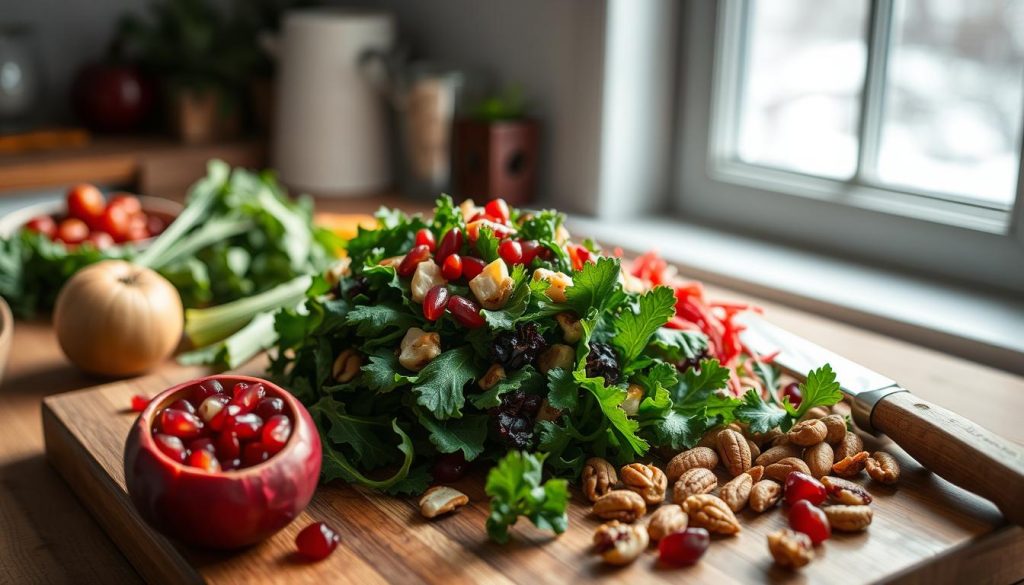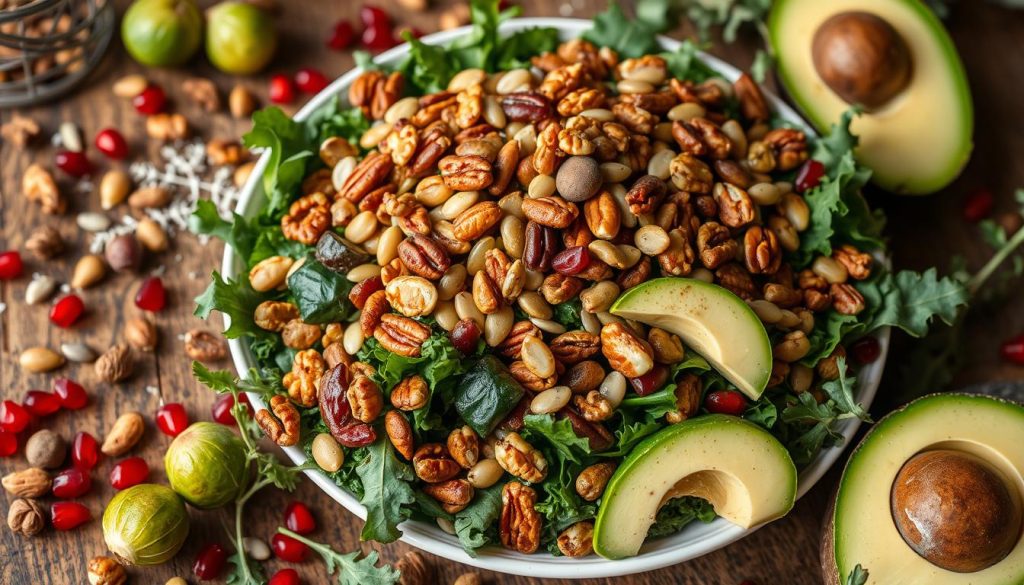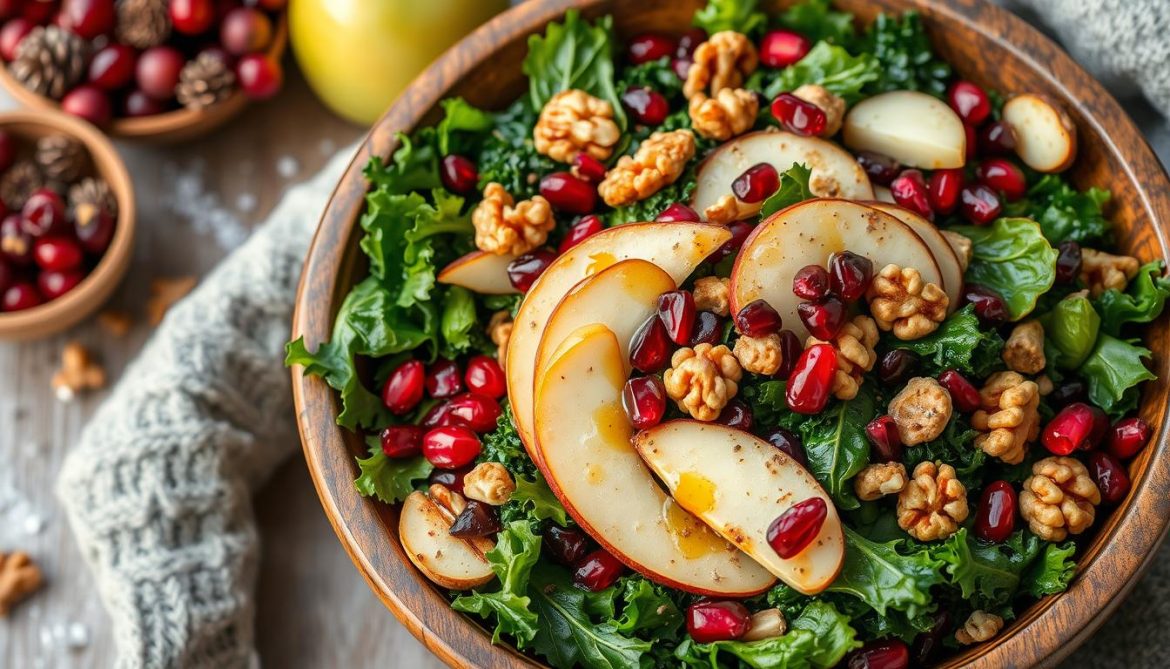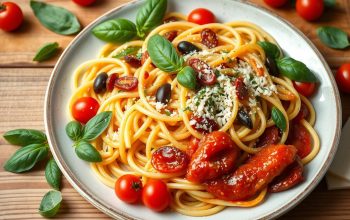Welcome to the vibrant world of winter salads! Just because it’s cold outside doesn’t mean you can’t enjoy fresh salads. Winter salads are a delicious way to celebrate the season’s best produce.
Imagine a plate full of color and texture. You’ll find crisp greens, roasted root vegetables, and unique flavors. These salads are more than just food; they’re a journey of taste and nutrition.
Seasonal produce is key to winter salads. You’ll find root veggies, kale, and citrus fruits. These ingredients create a mix of flavors that keeps you energized. I’m excited to share my top winter salad tips to make your meals amazing.
Winter salads are about more than just eating well. They’re about joy, creativity, and enjoying the season’s best. Get ready to see salads in a whole new light!
Why Winter Salads Are the Perfect Cold-Weather Comfort Food
Winter doesn’t mean saying goodbye to fresh, vibrant salads. Cold-weather greens are a nutritional powerhouse. They bring warmth, flavor, and health benefits to your plate.
Winter salads are more than just a meal. They’re a culinary adventure that nourishes both body and soul. Hearty salad ingredients offer comfort and nutrition during the cold months.
Balancing Nutrition and Seasonal Eating
Winter eating doesn’t have to be heavy. Cold-weather greens are a smart alternative. They keep you feeling satisfied and energized. Here are some nutritional benefits:
- Boost immune system with nutrient-dense ingredients
- Provide essential vitamins during low-sunlight months
- Offer variety in your winter meal rotation
The Psychology of Warm-Weather Foods in Winter
Our bodies crave different textures and flavors in cold months. Hearty salad ingredients bridge comfort food and healthy eating. Think roasted vegetables, warm grains, and rich proteins that make salads feel substantial and satisfying.
“A great winter salad is like a warm hug on a cold day – nourishing, comforting, and full of life!” – Culinary Nutritionist
| Winter Salad Component | Nutritional Benefit | Flavor Profile |
|---|---|---|
| Kale | High in Vitamin K | Earthy, Robust |
| Roasted Squash | Rich in Vitamin A | Sweet, Warm |
| Quinoa | Complete Protein | Nutty, Filling |
Join the winter salad revolution! With creative ingredients and a playful approach, you’ll make cold-weather eating delicious and nutritious.
Essential Winter Greens for Vibrant Seasonal Salads
Winter doesn’t mean saying goodbye to fresh, crisp greens! Seasonal produce offers an incredible array of nutritious winter meals. These meals feature hardy, flavor-packed leafy vegetables that thrive in colder temperatures. Let’s explore the green champions that will transform your winter salad game.
Dive into these incredible winter greens that pack a serious nutritional punch:
- Kale: The winter superfood king
- Collard greens: Robust and nutrient-dense
- Swiss chard: Colorful and mineral-rich
- Arugula: Peppery and vibrant
- Spinach: Classic cold-weather green
Each of these greens brings unique flavors and textures to your seasonal produce lineup. Kale, for instance, becomes sweeter after a frost, making it perfect for hearty winter salads.
“Winter greens aren’t just food – they’re nutrition powerhouses waiting to elevate your meals!” – Culinary Nutritionist
Let’s break down the nutritional profile of these winter green superstars:
| Green | Key Nutrients | Flavor Profile |
|---|---|---|
| Kale | Vitamins A, C, K | Earthy, slightly bitter |
| Collards | Calcium, Iron | Mild, slightly cabbage-like |
| Swiss Chard | Magnesium, Potassium | Slightly sweet, tender |
| Arugula | Vitamin K, Calcium | Peppery, sharp |
| Spinach | Iron, Folate | Mild, smooth |
Pro tip: Massaging tough greens like kale with a bit of olive oil can make them more tender and delicious in your nutritious winter meals. Your salads will never be boring again!
Immune-Boosting Ingredients to Power Your Winter Salads
Winter is the time to eat smart and keep your immune system strong. Making immune-boosting salads is not just about health. It’s also about making food that tastes great and helps fight off winter sickness.
Now, let’s explore the key ingredients that turn simple salads into nutritional wonders!
Citrus Fruits and Vitamin C Sources
Citrus salads are your best defense against winter bugs. Oranges, grapefruits, and tangerines are full of vitamin C. This vitamin helps your body fight off infections.
- Mandarin orange segments
- Grapefruit wedges
- Blood orange slices
Antioxidant-Rich Winter Vegetables
Winter veggies add amazing immune-boosting powers to your salads. The more colors you use, the better the protection!
| Vegetable | Immune Benefits |
|---|---|
| Kale | High in vitamins A, C, K |
| Red Bell Peppers | Massive vitamin C content |
| Butternut Squash | Beta-carotene rich |
Herbs and Spices for Immunity
Add herbs to your salads for extra health benefits. These natural healers do more than just taste good. They help keep you healthy.
“Food is thy medicine” – Ancient Wisdom
- Turmeric: Anti-inflammatory powerhouse
- Ginger: Supports circulation
- Garlic: Natural antibiotic
Pro tip: Mix these ingredients for a salad that’s both tasty and healthy!
Roasted Root Vegetables: Adding Warmth to Cold Dishes
Winter is the perfect time to make roasted vegetable salads into hearty meals. Root vegetables add magic to simple salads, making them warm, nutritious, and full of flavor.
Roasting root vegetables brings out their natural sweetness. It also creates a rich, caramelized exterior. This adds depth to winter salads. Some top ingredients for roasting include:
- Sweet potatoes
- Parsnips
- Carrots
- Butternut squash
- Beets
Now, let’s learn how to roast vegetables for the best flavor in your salads:
- Cut vegetables into uniform 1-inch cubes
- Toss with olive oil, salt, and pepper
- Roast at 425°F for 25-30 minutes
- Cool slightly before adding to salad
| Vegetable | Roasting Time | Flavor Profile |
|---|---|---|
| Sweet Potato | 25-30 minutes | Sweet, Caramelized |
| Parsnips | 30-35 minutes | Nutty, Slightly Spicy |
| Beets | 35-40 minutes | Earthy, Rich |
“Roasted root vegetables transform ordinary salads into extraordinary winter meals!” – Chef’s Kitchen Wisdom
Pro tip: Try different spice blends like smoked paprika or za’atar for unique flavors in your roasted vegetable salads.
Protein-Packed Winter Salad Combinations
Winter calls for meals that keep you energized and full. Protein is key to making your salads more than just sides. It turns them into hearty, filling meals that fight off winter’s tiredness.
Let’s explore protein-rich foods that boost your salads. They make every bite a satisfying experience!
Plant-Based Protein Options
Vegan fans, rejoice! Winter salads can be loaded with plant-based proteins. These options are satisfying and nourishing:
- Quinoa: A complete protein with all essential amino acids
- Roasted chickpeas for crunch and protein punch
- Tofu cubes seasoned with warming spices
- Edamame beans for texture and nutrition
Lean Meats and Fish Selections
Meat lovers, rejoice! These protein-rich options will keep you warm and full:
- Grilled chicken breast with herb seasoning
- Smoked salmon for omega-3 richness
- Seared turkey strips with winter spices
- Slow-cooked pulled chicken
“Protein transforms a simple salad into a complete, satisfying meal!” – Nutrition Experts
Mix these proteins with hearty winter greens and roasted veggies. You’ll get meals that are both nutritious and delicious.
Creative Dressing Recipes for Winter Salads
Dressings are the secret to making winter salads special. Let’s explore some amazing flavor mixes that highlight seasonal produce.
Making the perfect winter salad dressing is an art. It takes your salad to a whole new level. I’ll share recipes that will excite your taste buds!
Citrus-Infused Winter Vinaigrette
- Fresh orange juice
- Honey from local producers
- Dijon mustard
- Extra virgin olive oil
- Minced shallots
This vinaigrette adds a burst of citrus to your winter salads. It pairs well with hearty ingredients, offering a refreshing taste.
“A great dressing can transform a simple salad into a culinary adventure!” – Chef’s Secret
Warm Maple-Tahini Dressing
- Tahini paste
- Pure maple syrup
- Apple cider vinegar
- Warm water
- Cracked black pepper
This dressing is creamy and nutty, perfect for cold winter salads. It’s full of nutrients and adds a luxurious feel to roasted veggies.
Pro tip: Always whisk your dressings well and taste before serving. The right mix can make a salad unforgettable!
Hearty Grains and Seeds to Enhance Your Winter Bowl
Winter salads are about to get a serious upgrade! Hearty salad ingredients can turn your nutritious winter meals into filling masterpieces. Grains and seeds add texture, nutrition, and flavor to your winter bowl.
Let’s explore the grains that will change your salad game:
Ancient Grains for Modern Salads
- Quinoa: A protein-packed powerhouse that adds a light, fluffy texture
- Farro: Nutty and chewy, perfect for substantial winter salads
- Amaranth: Tiny grains with a delightful crunch and rich nutritional profile
These ancient grains are more than just trendy. They’re nutritional superstars that can make your winter salad a complete meal.
Seed Combinations for Extra Crunch
Seeds are tiny nutritional bombs that can elevate any salad. Try these knockout combinations:
- Pumpkin seeds + sunflower seeds
- Chia seeds + hemp hearts
- Flaxseeds + sesame seeds
“Grains and seeds are nature’s most delicious multivitamins!” – Nutrition Experts
Mixing different grains and seeds creates layers of nutrition and texture. This makes your winter salads absolutely irresistible. Experiment, have fun, and watch your salads transform!
Seasonal Fruit Additions for Natural Sweetness
Winter salads get a burst of life with seasonal fruits! Fruits aren’t just for summer. They can make your winter salads a true delight. Let’s see how these sweet treats can take your salads to the next level.
Fruits add a magical mix of flavors and textures to winter salads. Citrus fruits like oranges, grapefruits, and tangerines add a zesty kick. Pomegranate seeds burst with sweetness and are packed with nutrients.
- Pomegranate seeds: Antioxidant powerhouse
- Mandarin oranges: Vitamin C boost
- Persimmons: Unique sweet flavor profile
- Pears: Crisp texture and gentle sweetness
Choose fruits that match your salad’s base ingredients. Roasted pears go great with bitter greens. Citrus segments refresh kale and spinach.
| Fruit | Flavor Profile | Best Salad Pairings |
|---|---|---|
| Pomegranate | Tart, Sweet | Kale, Arugula |
| Oranges | Bright, Citrusy | Spinach, Bitter Greens |
| Pears | Mild, Sweet | Rocket, Blue Cheese |
“Fruits are nature’s candy – even in winter salads!” – Chef Maria Rodriguez
Pro tip: Slice fruits just before serving to keep them crisp. A squeeze of lemon juice helps keep their color bright in your salads.
Make-Ahead Winter Salad Techniques
Creating tasty winter salads doesn’t have to take up all your time. With a few smart tips, you can enjoy fresh salads every day without spending hours cooking.

When prepping winter salads, planning is key. It’s important to keep ingredients separate and fresh. This way, your salads will stay vibrant and delicious.
Smart Storage Tips for Fresh Ingredients
- Wash and dry leafy greens thoroughly before storage
- Store delicate greens in airtight containers with paper towels
- Chop hardy vegetables like kale and Brussels sprouts in advance
- Keep wet and dry ingredients separated until serving
Storing ingredients right can make your salads last longer. This makes meal prep quick and easy.
Batch Preparation Methods
| Ingredient Category | Prep Method | Storage Duration |
|---|---|---|
| Leafy Greens | Wash, dry, and store in sealed containers | 3-5 days |
| Roasted Vegetables | Prep and store in separate containers | 4-5 days |
| Protein Additions | Cook and portion in advance | 3-4 days |
Pro tip: Always dress your winter salads just before serving to maintain optimal texture and flavor!
“Meal prep is the secret weapon for enjoying fresh, nutritious winter salads without daily cooking stress.” – Culinary Nutrition Expert
Using these make-ahead tips, you’ll make winter salad prep easy and fun. It will help you stick to your healthy eating goals.
Winter Superfood Combinations for Maximum Nutrition
Discover how to make winter superfood salads that boost your immune system and keep you full of energy. Winter is not a time to give up on nutrition. It’s a chance to make salads that are full of health benefits.
Making nutritional powerhouse salads is about choosing the right ingredients. I’ll show you my top picks for superfood mix-ins that turn simple salads into nutritional powerhouses:
- Kale + Pomegranate Seeds: A dynamic duo loaded with antioxidants and vitamin C
- Quinoa + Roasted Beets: Protein-rich base with incredible blood-flow supporting nutrients
- Spinach + Citrus + Pumpkin Seeds: Triple threat for immune defense
“Food is your first line of defense. Make every bite count!” – Nutrition Experts
Winter superfood salads are not just random mixes. The right combinations can greatly increase your nutrition. Imagine a salad that works as hard as your winter coat to keep you healthy!
Pro tip for creating immune-boosting salads: Choose colorful ingredients. The more vibrant your salad, the more nutrients you get. Dark leafy greens, bright citrus fruits, and deep-colored root vegetables are your winter wellness allies.
- 🥬 Dark greens (rich in vitamins)
- 🍊 Citrus fruits (vitamin C boost)
- 🥜 Nuts and seeds (healthy fats)
Your body needs extra nourishment in winter. Give it what it needs with these amazing superfood combinations!
Warm Components to Transform Cold Salads
Winter salads don’t have to be boring or chilly! Let’s explore how to add warmth and excitement to your cold-weather dishes. This will make your taste buds dance with joy. The secret is all about creating temperature contrasts that bring your winter salads to life.
Transforming winter salads is an art form. It combines temperature, texture, and flavor. The key is to introduce warm elements that complement the crisp, fresh ingredients of your base salad.
Temperature Contrasts in Plating
Creating the perfect winter salad is all about balance. Here are some techniques to elevate your hearty salad ingredients:
- Warm roasted vegetables straight from the oven
- Seared protein placed on top of chilled greens
- Heated grains as a base for cold salad components
“The magic happens when hot meets cold – it’s culinary alchemy!” – Chef’s Secret
Quick-Seared Toppings That Wow
Imagine biting into a winter salad with perfectly seared elements. These bring warmth and depth. Some of my favorite quick-seared toppings include:
- Crispy pancetta
- Seared shrimp
- Caramelized tofu cubes
- Quickly charred winter squash
Pro tip: The key to amazing winter salads is creating a symphony of temperatures. A warm element can transform a simple cold salad into a comforting winter meal. This will keep you satisfied and energized!
Nutty and Crunchy Winter Salad Toppings
Crunch lovers, get ready to transform your nutritious winter meals with some seriously delightful toppings! Adding nuts and seeds to your hearty salad ingredients can elevate a simple dish into a textural masterpiece.

Nuts and seeds are your secret weapons for winter salads. They add crunch, nutrition, and depth. This turns an ordinary salad into an extraordinary culinary experience.
- Toasted Almonds: Crisp and elegant
- Pumpkin Seeds: Earthy and rich
- Walnuts: Robust and hearty
- Sunflower Seeds: Light and versatile
- Pecans: Sweet and buttery
Pro tip: Always toast your nuts and seeds before adding them to your salad. This simple step intensifies their flavor and brings out their natural oils.
“Texture is the unsung hero of any great salad. Without crunch, you’re just eating a pile of leaves!” – Chef’s Kitchen Wisdom
| Nut/Seed | Flavor Profile | Nutritional Boost |
|---|---|---|
| Almonds | Mild, slightly sweet | High in Vitamin E, protein |
| Pumpkin Seeds | Nutty, earthy | Rich in magnesium, zinc |
| Pecans | Rich, buttery | Heart-healthy fats |
Mixing different nuts and seeds creates a symphony of textures. This makes your winter salads irresistible. Don’t be afraid to experiment and find your perfect crunch combination!
Incorporating Fermented Foods for Gut Health
Winter is the perfect time to add gut-friendly ingredients to your meals. Fermented foods are like secret weapons. They make your salads taste amazing and support your health.
Fermentation turns simple ingredients into nutritional powerhouses. These foods are full of probiotics. They boost your digestive system and immune response.
Probiotic-Rich Add-ins for Your Winter Salads
- Kimchi: A spicy Korean ferment bursting with vitamins
- Sauerkraut: Crunchy, tangy cabbage packed with probiotics
- Pickled vegetables: Adds zest and gut-supporting microorganisms
- Kombucha: A fizzy drink that can be drizzled as a unique dressing
Fermentation Basics for Beginners
Don’t be scared of fermentation! Start with quick pickling techniques. Pro tip: Always use fresh, high-quality vegetables and clean equipment to ensure safe fermentation.
“Fermentation is like culinary magic – turning simple ingredients into nutritional superheroes!” – Gut Health Experts
By adding fermented foods to your meals, you’ll make salads that are both tasty and healthy. Your gut will love you for it!
Color Theory: Creating Visually Appealing Winter Salads
Winter salads are more than just food – they’re a canvas for art. They’re not just about taste; they’re about creating a feast for all your senses.
Color is key in making winter salads stand out. Imagine your plate as a painter’s palette. Each ingredient adds its own color and nutrition. The goal is to mix colors that look great and taste even better.
- Emerald greens from kale and spinach
- Bright orange from roasted butternut squash
- Deep purple from beetroot
- Crisp white from cauliflower
- Rich red from pomegranate seeds
Using color contrast is your secret to stunning salads. Mix dark ingredients with light ones for depth. A sprinkle of herbs or a colorful dressing can turn a simple salad into a work of art.
“Color is the language of visual nutrition – speak it boldly!” – Culinary Artist
Eating with your eyes first makes every bite better. Try new seasonal produce and let your creativity show through color!
Time-Saving Tips for Winter Salad Preparation
Hey fellow food lovers! Let’s explore how to make tasty winter salads fast. Meal prepping is my go-to for quick salads. Spend an hour on a Sunday chopping veggies, roasting roots, and prepping proteins. Then, store them in clear containers for easy access all week.
Get smart kitchen tools to cut down prep time. A mandoline slicer makes quick work of veggies, and a food processor chops ingredients fast. Keep pre-washed greens and chopped veggies in the fridge. This way, you can whip up healthy meals in minutes, not hours.
Batch cooking is key for winter salads. Roast veggies like butternut squash, brussels sprouts, and sweet potatoes on the weekend. Store them in the fridge for salads all week. Mix with quick grains like quinoa or farro for a protein-rich meal in no time!
Lastly, use high-quality prepared ingredients to save time. Rotisserie chicken, canned beans, and pre-cooked grains are big time-savers. Combine these with fresh produce for delicious, healthy salads without spending all day cooking.



